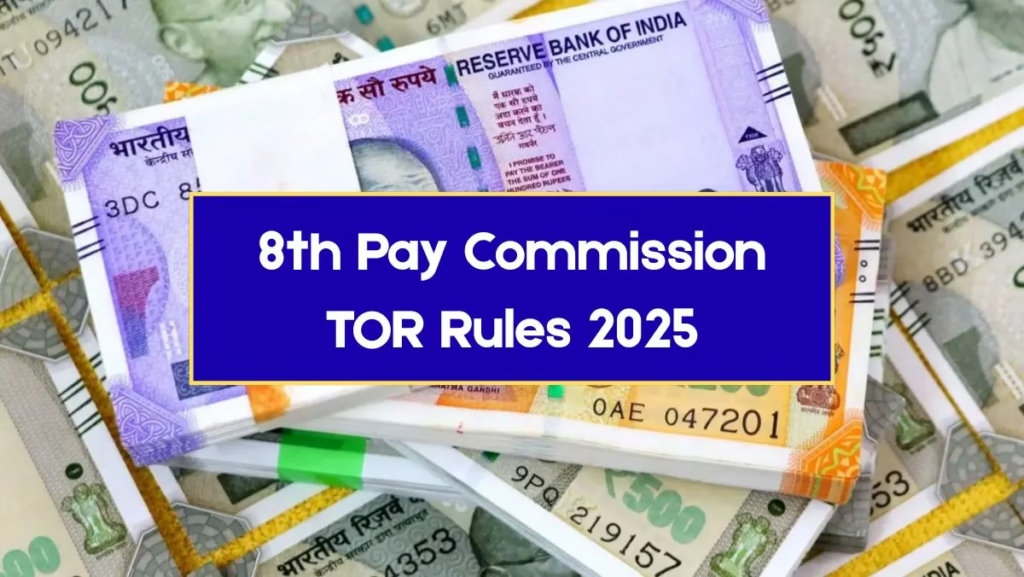8th Pay Commission TOR Rules 2025: The foundation of any successful pay commission lies in its Terms of Reference (TOR), yet many government employees remain unclear about what these rules actually mean and how they directly affect their financial future. The 8th Pay Commission’s TOR represents the blueprint that will determine salary structures, allowance calculations, pension benefits, and career progression for over 50 lakh central government employees and 65 lakh pensioners across India.
Understanding the TOR rules isn’t just an academic exercise—it’s crucial for every government employee who wants to comprehend how their compensation will be calculated, what benefits they can expect, and how their career progression will unfold under the new framework. The TOR serves as the official mandate that guides the commission’s work, defining boundaries, priorities, and methodologies that will shape government compensation for the next decade.
What Are Terms of Reference (TOR)?
ToR, or Terms of Reference, is a document that defines the scope of work for a commission, particularly a pay commission. It works like a blueprint that defines what areas the commission must look into (like salary, pension, allowances) and without the ToR, the commission has no official direction.
The TOR document establishes the legal framework within which the pay commission operates. It provides the commission with its authority to examine existing compensation structures, interview stakeholders, collect data, and make recommendations for changes. Without approved TOR, the commission cannot officially begin its work, which is why the finalization of these terms is so critical for the timeline of salary revisions.
8th Pay Commission TOR Key Components
Pay structure, allowances, welfare central government employees including New Pension scheme/Unified Pension scheme employees. Fixation of fitment pay factor and minimum pay based on the “Decent and dignified Living Wage” with reference to the recommendation of the 15 Indian Labour Conference and the Dr.Aykroyd formula with recent developments and life requirements which has undergone changes in last 65 years. These components form the backbone of what the commission will examine and revise.
The TOR encompasses salary structure reviews that go beyond simple percentage increases. The commission will examine the entire pay matrix system, looking at level classifications, stage progressions, and the mathematical relationships between different positions. This comprehensive review ensures that the pay structure remains logical, fair, and sustainable for future growth.
Allowance structures receive detailed attention in the TOR, covering everything from house rent allowance and transport allowance to specialized allowances for difficult postings and hazardous duties. The commission will evaluate whether current allowances adequately serve their intended purposes and recommend modifications or new allowances as needed.
$725 California Stimulus 2025: Who Gets It, How It Works and the Truth Behind the Buzz
8th Pay Commission 2025 Salary Matrix: New Pay Bands, Grade Pay & Increment Rules
Pension and retirement benefits form a major component of the TOR, particularly important given the large number of government retirees and their families who depend on these benefits. The terms will guide the commission’s examination of pension calculation methods, dearness relief mechanisms, and family pension provisions.
The TOR also addresses comparative analysis requirements, mandating that the commission study compensation trends in the private sector, public sector undertakings, and international public service organizations. This comparative approach ensures that government compensation remains competitive and attractive to qualified professionals.
Employee Categories and Coverage
The National Council of Joint Consultative Machinery (JCM) Staff Side has submitted its recommendations for the Terms of Reference (ToR) for the 8th Central Pay Commission (CPC), advocating significant changes in pay structure, allowances, and benefits for government employees and pensioners. The TOR clearly defines which employee categories fall within the commission’s purview and which are excluded.
Central government civilian employees across all ministries and departments are included in the TOR coverage. This encompasses employees in Groups A, B, C, and D, from entry-level positions to senior administrative roles. The comprehensive coverage ensures consistent application of new compensation structures across the entire central government workforce.
Defense personnel typically have separate pay commission arrangements, but the TOR may include provisions for coordination between civilian and defense pay structures to maintain appropriate relationships between different government service categories. This coordination prevents disparities that could affect morale or recruitment.
The TOR specifically addresses pensioners and family pension beneficiaries, ensuring that retired employees also benefit from pay commission recommendations. This inclusion reflects the government’s commitment to maintaining retired employees’ financial security and recognizing their past contributions to public service.
Employees covered under different pension schemes, including the old pension system, New Pension Scheme (NPS), and the newly introduced Unified Pension Scheme, receive attention in the TOR. This comprehensive approach ensures that all employees receive fair treatment regardless of when they joined government service.
$2000 Stimulus in August 2025? What’s Real and What’s Just Rumor
$600 Stimulus Check August 2025: Who Qualifies and How to Claim
Conclusion About 8th Pay Commission TOR Rules 2025
The 8th Pay Commission’s Terms of Reference represent more than administrative guidelines—they constitute the foundation upon which fair, sustainable, and effective government compensation will be built for the next decade. Understanding these TOR rules helps every government employee appreciate how their future compensation will be determined and what factors will influence their financial security.
As the TOR finalization process continues, government employees should stay informed about developments and actively participate in consultation processes when opportunities arise. The final terms will shape not just individual compensation but the entire landscape of government service in India.
The success of the 8th Pay Commission will ultimately be measured by its ability to create compensation structures that attract talented individuals to government service, retain experienced employees, and provide financial security for those who dedicate their careers to public service. The TOR rules serve as the roadmap for achieving these critical objectives.
FAQs About 8th Pay Commission TOR Rules 2025
What is the 8th Pay Commission, and why does it matter?
The 8th Pay Commission is a panel set up by the Indian government to review and revise salaries, allowances, and pensions for central government employees and pensioners. Announced on January 16, 2025, it’s expected to impact around 48 lakh employees and 67 lakh pensioners, with changes likely effective from January 1, 2026.
What are the Terms of Reference (ToR) for the 8th Pay Commission?
The ToR is like a blueprint that guides what the commission will focus on. It outlines:
Reviewing current pay structures and allowances (like Dearness Allowance, House Rent Allowance).
Fixing pay disparities across departments.
Ensuring salaries align with market standards and inflation.
Updating pension schemes and retirement benefits.
Analyzing economic impacts of pay hikes to boost spending.
Consulting stakeholders like state governments and unions.
As of August 2025, the ToR is still being finalized, with inputs from employee unions and ministries expected by April 2026.
What about allowances like DA, HRA, and others?
Allowances will be recalculated based on the new basic pay:
Dearness Allowance (DA): Currently at 55% (July 2025), it’ll likely reset to 0% when the new matrix kicks in, then rise gradually to offset inflation.
House Rent Allowance (HRA): Likely to stay at 27% (X cities), 18% (Y), 9% (Z), but applied to higher basic pay, so actual amounts increase. For example, HRA for a ₹46,260 basic in a metro could be ₹12,490 vs. ₹4,860 now.
Transport Allowance: Expected to rise (e.g., ₹3,600–₹7,200 for higher levels).
Children’s Education Allowance: May extend to postgraduate levels, currently ₹2,250 per child.
Employee unions are also pushing for a 50% DA merger with basic pay, but that’s not confirmed yet.
Who is covered by the 8th Pay Commission?
It applies to:
Central government employees (industrial and non-industrial).
Defence personnel (Army, Navy, Air Force).
Railway staff.
Pensioners, including defence retirees.
Unions are pushing to include Gramin Dak Sevaks (postal workers) and Election Commission staff too. State governments often follow suit, so state employees might see similar revisions later.
What’s the fitment factor, and why is it a big deal?
The fitment factor multiplies your current basic pay to set the new one. A higher factor (say 2.86 vs. 1.83) means bigger raises. For instance, a ₹50,000 basic could become ₹91,500 (1.83) or ₹1,43,000 (2.86). It’s crucial because it determines how much your take-home grows and affects allowances tied to basic pay. Lower estimates (1.8–2.0) have sparked some concern, as they’d mean hikes as low as 13%, compared to the 7th Commission’s 14.3%.

